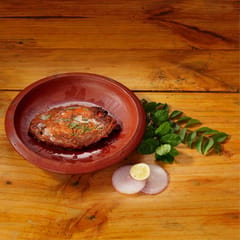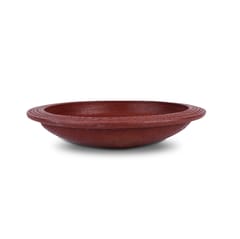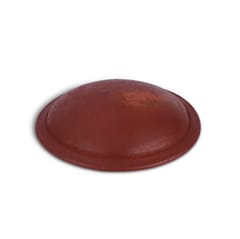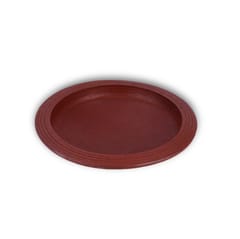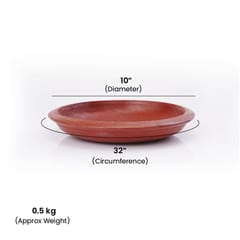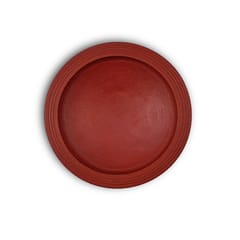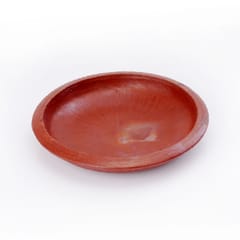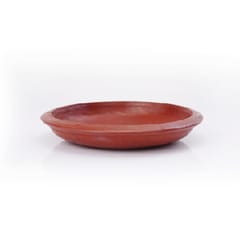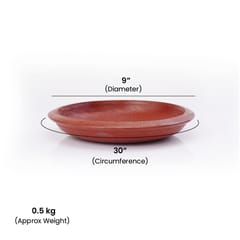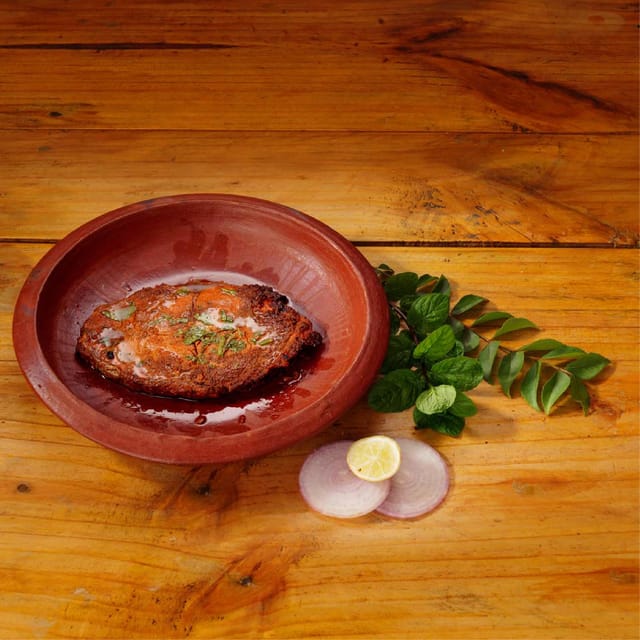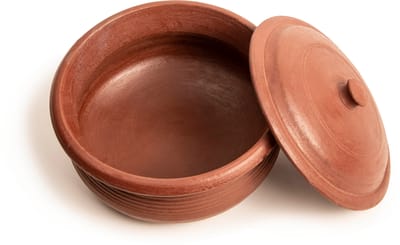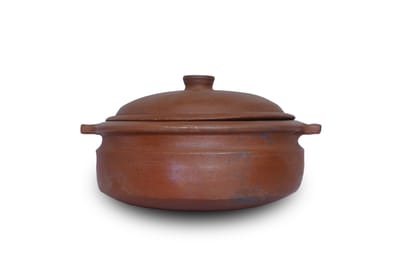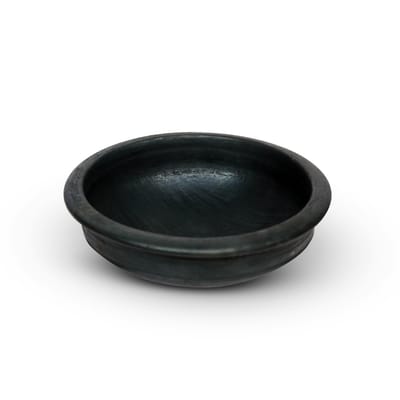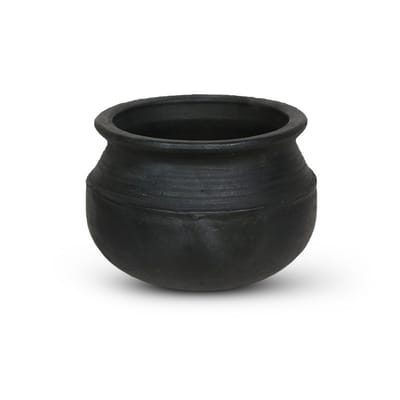Show cart summary 0 Items
Please Add Some Items
The term Tawa by itself means nothing but it’s the kind of pan that you use to cook on it that gives it its name. So what is a Mud Frying Tawa? It’s actually one of the traditional cooking vessels made out of earthen clay that has been put in great use in India, especially by the villagers. They make chapatis in it and they also use it for fry food because of which they even have an add-on benefit for your health as it controls the use of oil thereby reducing the fat content in food.
The Convex shape of the Tawa help to keeps a moderate amount of liquid within it while cooking/shallow frying.
Benefits :
- This pot is made of fresh and natural clay. No chemical is applied to make it smooth or shiny. It has all the goodness of the clay pots used by our grannies. So, it is a safe and healthy choice for all of us.
- Clay is somewhat porous so heat and moisture circulate through the pot, unlike metal & enamel pots therefore it is perfect for slow cooking without overheating. This helps to retain all the natural vitamins and minerals of the food. Clay pots add many essential nutrients like calcium, phosphorus, iron, magnesium and sulphur to food.
- Clay is alkaline in nature and neutralizes acidic food. Hence, clay helps in maintaining a healthy pH balance in the body and reduces common stomach problems faced by youngsters due to excessive consumption of fast food.
- Compatible with gas stoves, microwave ovens & traditional chulhas. Don't heat the pots empty,if you are preparing curry add oil first then heat the pot.
- Retains heat for a longer period. Thus keeping your food warm for a longer duration avoiding repetitive re-heating.
How to Clean:
For general and deep cleaning, allow the earthen pot to soak overnight in the sink in water mixed with baking soda. Add 3 tablespoons of baking soda per liter of hot water. Wash the pot with a soft bristle brush or nonmetallic scrubbing pad. Do not use abrasive scouring powders because they will clog the pores and make the pot useless. Salt/ash can be used as a non-toxic alternative to chemical cleaners. Sprinkle salt/ash into the pot and scour it using a scouring pad. Rinse the pot with warm water and allow it to dry.
If any mold forms during storage periods sprinkle baking soda inside the pot, then rinse with warm water using a brush to remove the mold. If clay pores become clogged, the pot should be cooked in boiling water for about 30 minutes.
Never use soap or detergent because the porous nature of clay will absorb the soap. The detergent may leave an unpleasant soapy taste and this flavor will leach back into your next clay pot meal.
Storage:
After washing, make sure to store your earthenware in dry and well-ventilated areas. This will eliminate the risk of mold growth inside the pot.
If bacterial growth is of concern, dry the pots in a 200°F oven for 30 minutes before storing in a cool, dry place.
SKU-QJSB4ZZL25QV- Home
- Mudpot
- Cooking pots
- Mitti ka tawa | Clay Frying pan - Mudkart
Mitti ka tawa | Clay Frying pan - Mudkart
- 1. 100% handmade product and eco-friendly.
- 2. Retains heat for a longer period. Thus keeping your food warm for a longer duration avoiding repetitive re-heating.
- 3. Alkaline nature of clay neutralizes the acidity of the food and maintains the pH balance.
- 4. The porous nature of clay pot retains the moisture and aroma.
- 5. It's seasoned, so you don’t have to worry about any pre-processing.
- 6. Before using wash it thoroughly with plain water.
- 7. It is a handmade product therefore size and shape may slightly vary.
| VARIANT | SELLER | PRICE | QUANTITY |
|---|
Description of product
The term Tawa by itself means nothing but it’s the kind of pan that you use to cook on it that gives it its name. So what is a Mud Frying Tawa? It’s actually one of the traditional cooking vessels made out of earthen clay that has been put in great use in India, especially by the villagers. They make chapatis in it and they also use it for fry food because of which they even have an add-on benefit for your health as it controls the use of oil thereby reducing the fat content in food.
The Convex shape of the Tawa help to keeps a moderate amount of liquid within it while cooking/shallow frying.
Benefits :
- This pot is made of fresh and natural clay. No chemical is applied to make it smooth or shiny. It has all the goodness of the clay pots used by our grannies. So, it is a safe and healthy choice for all of us.
- Clay is somewhat porous so heat and moisture circulate through the pot, unlike metal & enamel pots therefore it is perfect for slow cooking without overheating. This helps to retain all the natural vitamins and minerals of the food. Clay pots add many essential nutrients like calcium, phosphorus, iron, magnesium and sulphur to food.
- Clay is alkaline in nature and neutralizes acidic food. Hence, clay helps in maintaining a healthy pH balance in the body and reduces common stomach problems faced by youngsters due to excessive consumption of fast food.
- Compatible with gas stoves, microwave ovens & traditional chulhas. Don't heat the pots empty,if you are preparing curry add oil first then heat the pot.
- Retains heat for a longer period. Thus keeping your food warm for a longer duration avoiding repetitive re-heating.
How to Clean:
For general and deep cleaning, allow the earthen pot to soak overnight in the sink in water mixed with baking soda. Add 3 tablespoons of baking soda per liter of hot water. Wash the pot with a soft bristle brush or nonmetallic scrubbing pad. Do not use abrasive scouring powders because they will clog the pores and make the pot useless. Salt/ash can be used as a non-toxic alternative to chemical cleaners. Sprinkle salt/ash into the pot and scour it using a scouring pad. Rinse the pot with warm water and allow it to dry.
If any mold forms during storage periods sprinkle baking soda inside the pot, then rinse with warm water using a brush to remove the mold. If clay pores become clogged, the pot should be cooked in boiling water for about 30 minutes.
Never use soap or detergent because the porous nature of clay will absorb the soap. The detergent may leave an unpleasant soapy taste and this flavor will leach back into your next clay pot meal.
Storage:
After washing, make sure to store your earthenware in dry and well-ventilated areas. This will eliminate the risk of mold growth inside the pot.
If bacterial growth is of concern, dry the pots in a 200°F oven for 30 minutes before storing in a cool, dry place.

